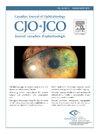利用皮肤黑色素瘤基因表达面板对转移性与非转移性结膜黑色素瘤进行基因分析。
IF 2.8
4区 医学
Q1 OPHTHALMOLOGY
Canadian journal of ophthalmology. Journal canadien d'ophtalmologie
Pub Date : 2024-10-02
DOI:10.1016/j.jcjo.2024.09.004
引用次数: 0
摘要
目的:结膜黑色素瘤(CJM)是一种罕见的粘膜黑色素瘤亚型:结膜黑色素瘤(CJM)是粘膜黑色素瘤的一种罕见亚型。尽管人们对结膜黑色素瘤的遗传学有了越来越多的了解,但预测患者的预后仍然具有挑战性。在此,我们试图了解最初为皮肤黑色素瘤(CM)开发并验证的 31 基因表达谱(31-GEP)测试(即 DecisionDx-Melanoma)是否有助于预测 CJM 患者的预后:我们对 10 名 CJM 患者进行了单中心回顾性审查和基因表达谱分析:每个原发性肿瘤的去身份化存档样本被送往 Castle Biosciences,在那里进行 31-GEP 检测。对患者进行随访,直至死亡或切除术后至少 5 年,并监测肿瘤复发或转移扩散情况。通过独立的 t 检验比较非转移组和转移组的单个基因表达的平均折叠变化:结果:50%的患者出现了转移性疾病,总生存期缩短(3.6 个月 vs 9.3 个月;P = 0.018)。10例患者中有4例(2例非转移性患者和2例转移性患者)的肿瘤样本通过了Castle Biosciences公司的质量控制,可以进行分类。所有转移性患者和一名非转移性患者被定为 2B 级。最后一名非转移性患者被定为 1B 级。在单个基因分析中,转移组的 BAP1 表达明显减少(p = 0.03):在评估 CM 基因表达面板是否有助于对 CJM 患者进行风险分层时,我们发现葡萄膜黑色素瘤相关基因 BAP1 可能很重要。要确定该基因和其他差异表达基因在 CJM 预后中的相关性,还需要更多样本量更大的研究。本文章由计算机程序翻译,如有差异,请以英文原文为准。
Genetic analysis of metastatic versus nonmetastatic conjunctival melanoma using a cutaneous melanoma gene expression panel
Objective
Conjunctival melanoma (CJM) is a rare subtype of mucosal melanomas. Despite an increasing understanding of CJM genetics, predicting patient prognosis remains challenging. Here we sought to see if a 31-gene expression profile (31-GEP) test (i.e., DecisionDx-Melanoma) originally developed and validated for cutaneous melanoma (CM) could be useful in the prognostication of patients with CJM.
Design/Participants
We performed a single-center retrospective review and gene expression profiling of 10 patients with CJM.
Methods
Deidentified archived samples of each primary tumor were sent to Castle Biosciences, where 31-GEP testing was performed. Patients were followed until death or a minimum of 5 years postexcision and monitored for tumor recurrence or metastatic spread. Mean fold change in individual gene expression was compared between nonmetastatic and metastatic groups via independent t-tests.
Results
Fifty percent of patients developed metastatic disease and had reduced overall survival (3.6 vs 9.3 months; p = 0.018). In 4 of 10 patients, two nonmetastatic and two metastatic, tumor samples passed Castle Biosciences quality control allowing for class designation. All metastatic patients and one nonmetastatic patient were designated as class 2B. The final nonmetastatic patient was designated as class 1B. In individual gene analysis, BAP1 expression was significantly reduced in the metastatic group (p = 0.03).
Conclusions
In assessing if a CM gene expression panel could aid in the risk stratification of patients with CJM, we found that the uveal melanoma-relevant gene, BAP1, may be important. Additional studies with larger sample sizes are needed to determine the relevance of this and other differentially expressed genes in CJM prognostication.
Objectif
Le mélanome de la conjonctive (MCJ) est une forme rare de mélanome de la muqueuse. Bien que l’on comprenne de mieux en mieux la génétique du MCJ, il demeure difficile d’établir un pronostic. Nous avons donc vérifié si le test du profil d'expression de 31 gènes (31-GEP) de DecisionDx-Melanoma, qui avait été créé et validé pour le mélanome cutané (MC), pouvait être utile dans l’établissement du pronostic des patients présentant un MCJ.
Nature/Participants
Il s’agit d’une revue de synthèse rétrospective réalisée dans un établissement unique portant sur le profilage d’expression génique de 10 patients atteints d’un MCJ.
Méthodes
Des échantillons archivés et dépersonnalisés de chacune des tumeurs primaires ont été envoyés au laboratoire Castle Biosciences, où a eu lieu le test du 31-GEP. Les patients ont été suivis jusqu’à leur décès ou pendant au moins 5 ans après l’excision. Ils ont également fait l’objet d’une surveillance de la récurrence tumorale ou de l’apparition de métastases. Le changement de plis (fold change) moyen de l’expression génique individuelle a été comparé entre les groupes exempts de métastases et porteurs de métastases grâce à des tests t indépendants.
Résultats
Ainsi, 50 % des patients ont présenté des métastases, et leur survie globale a été moindre (3,6 vs 9,3 mois; p = 0,018). Les échantillons tumoraux de 4 patients (dont 2 étaient exempts et les 2 autres, porteurs de métastases) répondaient aux normes de contrôle de la qualité de Castle Biosciences, ce qui a permis d’en désigner la classe. On a attribué la classe 2B à tous les porteurs de métastases et à 1 seul patient exempt de métastases. Le dernier patient sans métastases s’est vu attribuer la classe 1B. Lors de l’analyse génique individuelle, l’expression de BAP1 était significativement réduite au sein du groupe porteur de métastases (p = 0,03).
Conclusions
En vérifiant si le profilage d’expression génique du MC pouvait servir à stratifier le risque chez les patients atteints d’un MCJ, nous avons découvert qu’un gène pertinent dans le mélanome de l’uvée, BAP1, pouvait jouer un rôle important. D’autres études de plus vaste envergure s’imposent pour confirmer la pertinence de ce gène et d’autres gènes différentiellement exprimés dans l’établissement du pronostic du MCJ.
求助全文
通过发布文献求助,成功后即可免费获取论文全文。
去求助
来源期刊
CiteScore
3.20
自引率
4.80%
发文量
223
审稿时长
38 days
期刊介绍:
Official journal of the Canadian Ophthalmological Society.
The Canadian Journal of Ophthalmology (CJO) is the official journal of the Canadian Ophthalmological Society and is committed to timely publication of original, peer-reviewed ophthalmology and vision science articles.

 求助内容:
求助内容: 应助结果提醒方式:
应助结果提醒方式:


